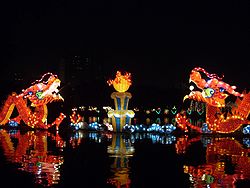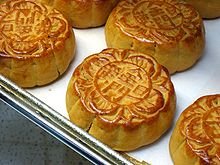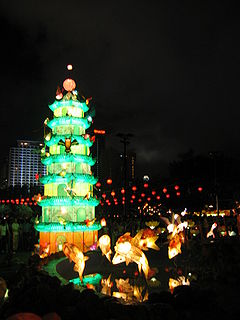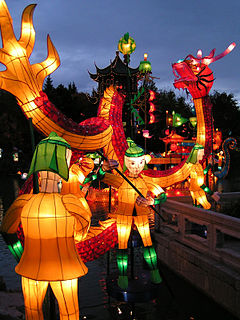- Mid-Autumn Festival
-
For other harvest festivals that may be known as Mid-Autumn Festival, see Mid-Autumn Festival (disambiguation).For the Chinese New Year Lantern Festival known as Yuan Xiao (元宵節), Chap Goh Meh, Yuen Siu (元宵), Shang Yuan (上元), and Tết Nguyên Tiêu", see Lantern Festival.
Mid-Autumn Festival 
Mid-Autumn Festival decorations in BeijingOfficial name Zhōngqiū Jié (中秋節, 中秋节) Also called Moon Festival
Mooncake Festival
Lantern Festival
Peh Goeh Cheh (八月節)Observed by Chinese, Taiwanese, Vietnamese Type Cultural, Religious Significance Celebrates the end of the fall harvest Date 15th day of the 8th lunar month 2011 date September 12 2012 date September 30 Observances consumption of mooncakes, worship of deities (Chang'e) Related to Tết Trung Thu, Chuseok Mid-Autumn Festival 
Mooncakes, often eaten during the festival Chinese name Traditional Chinese 中秋節 Simplified Chinese 中秋节 Transcriptions Hakka - Romanization Chung ciu tset Mandarin - Hanyu Pinyin Zhōngqiūjié - Wade–Giles Chung ch'iu chieh Min - Hokkien POJ Tiong-chhiu-chiat Cantonese (Yue) - Jyutping Zung1 cau1 zit3 - Yale Romanization Jūng chāu jit Min name Chinese 八月節 Transcriptions Min - Hokkien POJ Peh-go̍eh-cheh - Min-dong BUC Báik-nguŏk-cáik Vietnamese name Quốc ngữ Tết Trung Thu Chữ nôm 節中秋 The Mid-Autumn Festival (Chinese: 中秋節), also known as the Moon Festival or Mooncake Festival or Zhongqiu Festival, is a popular lunar harvest festival celebrated by Chinese and Vietnamese people.[1] A description of the festival first appeared in Rites of Zhou, a written collection of rituals of the Western Zhou Dynasty from 3,000 years ago.[1] The celebration became popular during the early Tang Dynasty.[1] The festival is held on the 15th day of the eighth month in the Chinese calendar, which is in September or early October in the Gregorian calendar, close to the autumnal equinox.[1] The Government of the People's Republic of China listed the festival as an "intangible cultural heritage" in 2006, and it was made a Chinese public holiday in 2008.[1] It is also a Taiwanese public holiday.
Contents
Traditions
The Mid-Autumn Festival is one of the few most important holidays in the Chinese calendar, the others being Spring Festival and Winter Solstice.[1] Accompanying the celebration, there are additional cultural or regional customs, such as:
- Eating mooncakes.[1][2]
- Matchmaking. In some parts of China, dances are held for young men and women to find partners. "One by one, young women are encouraged to throw their handkerchiefs to the crowd. The young man who catches and returns the handkerchief has a chance of romance."[1]
- Carrying brightly lit lanterns, lighting lanterns on towers, floating sky lanterns.[1]
- Burning incense in reverence to deities including Chang'e
- Fire Dragon Dances.[1]
- Moon rabbit is a traditional icon.[1]
Stories of the Mid-Autumn Festival
Houyi and Chang'e
Celebration of the Mid-Autumn Festival is strongly associated with the legend of Houyi and Chang'e, the Moon Goddess of Immortality. Tradition places these two figures from Chinese mythology at around 2200 BCE, during the reign of the legendary Emperor Yao, shortly after that of Huangdi. Unlike many lunar deities in other cultures who personify the moon, Chang'e simply lives on the moon but is not the moon herself.
There are many variants and adaptations of the legend of Chang'e that frequently contradict each other. However, most versions of the legend involve some variation of the following elements: Houyi, the Archer, an emperor, either benevolent or malevolent, and an elixir of life.
One version of the legend states that Houyi was an immortal and Chang'e was a beautiful young girl, working in the palace of the Jade Emperor (the Emperor of Heaven, 玉帝 pinyin:Yùdì) as an attendant to the Queen Mother of the West (the Jade Emperor's wife). Houyi aroused the jealousy of the other immortals, who then slandered him before the Jade Emperor. Houyi and his wife, Chang'e, were subsequently banished from heaven. They were forced to live on Earth. Houyi had to hunt to survive and became a skilled and famous archer.
At that time, there were ten suns, in the form of three-legged birds, residing in a mulberry tree in the eastern sea. Each day one of the sun birds would have to travel around the world on a carriage, driven by Xihe, the 'mother' of the suns. One day, all ten of the suns circled together, causing the Earth to burn. Emperor Yao, the Emperor of China, commanded Houyi to use his archery skill to shoot down all but one of the suns. Upon completion of his task, the Emperor rewarded Houyi with a pill that granted eternal life. Emperor Yao advised Houyi not to swallow the pill immediately but instead to prepare himself by praying and fasting for a year before taking it.[3] Houyi took the pill home and hid it under a rafter. One day, Houyi was summoned away again by Emperor Yao. During her husband's absence, Chang'e, noticed a white beam of light beckoning from the rafters, and discovered the pill. Chang'e swallowed it and immediately found that she could fly. Houyi returned home, realizing what had happened he began to reprimand his wife. Chang'e escaped by flying out the window into the sky.[3]
Houyi pursued her halfway across the heavens but was forced to return to Earth because of strong winds. Chang'e reached the moon, where she coughed up part of the pill.[3] Chang'e commanded the hare that lived on the moon to make another pill. Chang'e would then be able to return to Earth and her husband.[citation needed]
The legend states that the hare is still pounding herbs, trying to make the pill. Houyi built himself a palace in the sun, representing "Yang" (the male principle), in contrast to Chang'e's home on the moon which represents "Yin" (the female principle). Once a year, on the night of the Mid-Autumn Festival, Houyi visits his wife. That is the reason why the moon is very full and beautiful on that night.[3]
This description appears in written form in two Western Han dynasty (206 BC-24 AD) collections; Shan Hai Jing, the Classic of the Mountains and Seas and Huainanzi, a philosophical classic.[4]
Another version of the legend, similar to the one above, differs in saying that Chang'e swallowed the pill of immortality because Peng, one of Houyi's many apprentice archers, tried to force her to give the pill to him. Knowing that she could not fight off Peng, Chang'e had no choice but to swallow the pill herself.[citation needed]
Other versions say that Houyi and Chang'e were still immortals living in heaven at the time that Houyi killed nine of the suns. The sun birds were the sons of the Jade Emperor, who punished Houyi and Chang'e by forcing them to live on Earth as mortals. Seeing that Chang'e felt extremely miserable over her loss of immortality, Houyi decided to find the pill that would restore it. At the end of his quest, he met the Queen Mother of the West, who agreed to give him the pill, but warned him that each person would only need half a pill to regain immortality. Houyi brought the pill home and stored it in a case. He warned Chang'e not to open the case, and then left home for a while. Like Pandora in Greek mythology, Chang'e became curious. She opened up the case and found the pill, just as Houyi was returning home. Nervous that Houyi would catch her, discovering the contents of the case, she accidentally swallowed the entire pill, and started to float into the sky because of the overdose.
Some versions of the legend do not refer to Houyi or Chang'e as having previously been immortals and initially present them as mortals instead.[citation needed]
There are also versions of the story in which Houyi was made king as a reward for killing nine of the suns and saving the people. However, King Houyi became a despot who either stole a pill of immortality from the Queen Mother of the West or learned that he could make such a pill by grinding up the body of a different adolescent boy every night for a hundred nights. Chang'e stole the pill and swallowed it herself, either to stop more boys being killed or to prevent her husband's tyrannical rule from lasting forever.[citation needed]
The Hare or The Jade Rabbit
According to tradition, the Jade Rabbit pounds medicine, together with the lady, Chang'e, for the gods. Others say that the Jade Rabbit is a shape, assumed by Chang'e herself. The dark areas to the top of the full moon may be construed as the figure of a rabbit. The animal's ears point to the upper right, while at the left are two large circular areas, representing its head and body.[5]
Overthrow of Mongol rule
According to a widespread folk tale (not necessarily supported by historical records), the Mid-Autumn Festival commemorates an uprising in China against the Mongol rulers of the Yuan Dynasty (1280–1368) in the 14th century.[6] As group gatherings were banned, it was impossible to make plans for a rebellion.[6] Noting that the Mongols did not eat mooncakes, Liu Bowen (劉伯溫) of Zhejiang Province, advisor to the Chinese rebel leader Zhu Yuanzhang, came up with the idea of timing the rebellion to coincide with the Mid-Autumn Festival. He sought permission to distribute thousands of moon cakes to the Chinese residents in the city to bless the longevity of the Mongol emperor. Inside each cake, however, was inserted a piece of paper with the message: "Kill the Mongols on the 15th day of the 8th month" (traditional Chinese: 八月十五殺韃子; simplified Chinese: 八月十五杀鞑子).[6] On the night of the Moon Festival, the rebels successfully attacked and overthrew the government. What followed was the establishment of the Ming Dynasty (1368–1644), under Zhu. Henceforth, the Mid-Autumn Festival was celebrated with moon cakes on a national level.
Taiwanese version
Since the middle of the 1980’s, Taiwanese started the trend of barbecuing with friends and family at the Mid-Autumn Festival. This trend traces from different statements, some say that it started because of the boost of commercial companies, others say that it is because people usually get hungry when they are watching the moon, so outdoors barbecue has become widespread among people. However, the take-off of the Taiwanese economy and the influence of western life styles was also a reason which made people change their traditional customs. Mooncakes are typically round but smaller, with less elaborate fillings. More recently, some versions of the cake from Hong Kong seem to be gaining popularity.
Vietnamese version
The Mid-Autumn festival is named "Tết Trung Thu" in Vietnamese.
The Vietnamese version of the holiday recounts the legend of Cuội, whose wife accidentally urinated on a sacred banyan tree. Soon after desecrating the tree, she sat on one of the tree branches and the sacred tree began to grow and continued until it finally reached the moon, leaving Cuội's wife stranded there. Every year, during the Mid-Autumn Festival, children light lanterns and participate in a procession to show Cuội's wife the way back to Earth.[7]
In Vietnam, Mooncakes are typically square rather than round, though round ones do exist. Besides the indigenous tale of the banyan tree, other legends are widely told including the story of the Moon Lady, and the story of the carp who wanted to become a dragon.[7]
One important event before and during the Vietnamese Mid-Autumn Festival are lion dances. Dances are performed by both non-professional children's groups and trained professional groups. Lion dance groups perform on the streets, going to houses asking for permission to perform for them. If the host consents, the "lion" will come in and start dancing as a blessing of luck and fortune for the home. In return, the host gives luck money to show their gratitude.
Dates
The Mid-Autumn Festival is held on the 15th day of the eighth month in the Chinese calendar, which is in September or early October in the Gregorian calendar. In 2010 the Mid-Autumn Festival fell on September 22. It will occur on these days in coming years:[8]
- 2012: September 30
- 2013: September 19
- 2014: September 8
- 2015: September 27
- 2016: September 15
- 2017: October 4
- 2018: September 24
- 2019: September 13
- 2020: October 1
See also
- Chinese New Year
- Chinese holidays
- List of Harvest Festivals
- Tidal bore of Qiantang River
- Vietnamese holidays
- Vietnamese culture
References
- ^ a b c d e f g h i j k "Mid-Autumn Festival and its traditions". Xinhua News Agency. September 12, 2011. http://news.xinhuanet.com/english2010/culture/2011-09/12/c_131134150.htm. Retrieved 2011-09-12. "The festival, celebrated on the 15th day of the eighth month in the Chinese calendar, has no fixed date on the Western calendar, but the day always coincides with a full moon. It is also known as the Moon Festival. Descriptions of "Mid-Autumn" first appeared in "Rites of the Zhou," a collection of ritual matters of the Western Zhou Dynasty 3,000 years ago. It described the eighth lunar month, the second month of autumn, as "mid autumn." The Chinese began celebrating the Mid-Autumn Festival in the early Tang Dynasty (618 - 907), a period of material abundance and cultural blossoming. ..."
- ^ "Chinese Communities Worldwide Celebrate Mid-Autumn Festival". Voice of America. September 12, 2011. http://www.voanews.com/english/news/asia/east-pacific/Chinese-Communities-Worldwide-Celebrate-Mid-Autumn-Festival-129648443.html. Retrieved 2011-09-12. "The origins of the centuries-old holiday, also known as the Moon Festival, are lost in myth. But today it has become an occasion for families to reunite under the full moon - a symbol of happiness and prosperity - and exchange traditional pastries known as moon cakes. ..."
- ^ a b c d Chinatown.com.au
- ^ Shanghai me
- ^ Chinatown Online - your guide to all things Chinese
- ^ a b c Examination of the legend against the historical backdrop of mongol dynasty
- ^ a b familyculture.com tettrungthu
- ^ "Chinese Lunar Network" (in Simplified Chinese). http://nongli114.com/index.php/lunarHoliday/2009/21.html.
 Public holidays in the People's Republic of China
Public holidays in the People's Republic of ChinaGolden Weeks Other Holidays New Year's Day • Lantern Festival • Qingming Festival • Workers' Day • Duanwu Festival • Mid-Autumn FestivalNew Year's Day · Lunar New Year (3 days) · Ching Ming Festival · Good Friday · The day following Good Friday · Easter Monday · The Birthday of the Buddha · Labour Day · Tuen Ng Festival · Hong Kong Special Administrative Region Establishment Day · The day following the Chinese Mid-Autumn Festival · National Day · Chung Yeung Festival · Christmas Day · The first weekday after Christmas DayTaiwan topics History TopicsPolitics Society Culture Economy Geography - Cities
- Endemic species
- Hot springs
- Islands
- Mountains
- National parks
- Rivers
- Scenic areas
- Volcanoes
 Vietnam topics
Vietnam topicsHistory Politics Government ExecutiveLegislativeEconomy Agriculture · Doi Moi · Five-Year Plans · International rankings · Manufacturing · Tourism · Vietnamese dong (VND)Transport Geography Society Arts Other topics Communications · National flag / coat of arms · Provinces · Diaspora · Human rights (LGBT rights) · Vietnamese studiesCategories:- Autumn holidays
- Harvest festivals
- Festivals in China
- Festivals in Taiwan
- Festivals in Vietnam
- Chinese holidays
- Public holidays in Vietnam
- Holidays in Hong Kong
- Public holidays in the Republic of China
- September observances
- Chinese traditional religion
- Vietnamese culture
Wikimedia Foundation. 2010.




